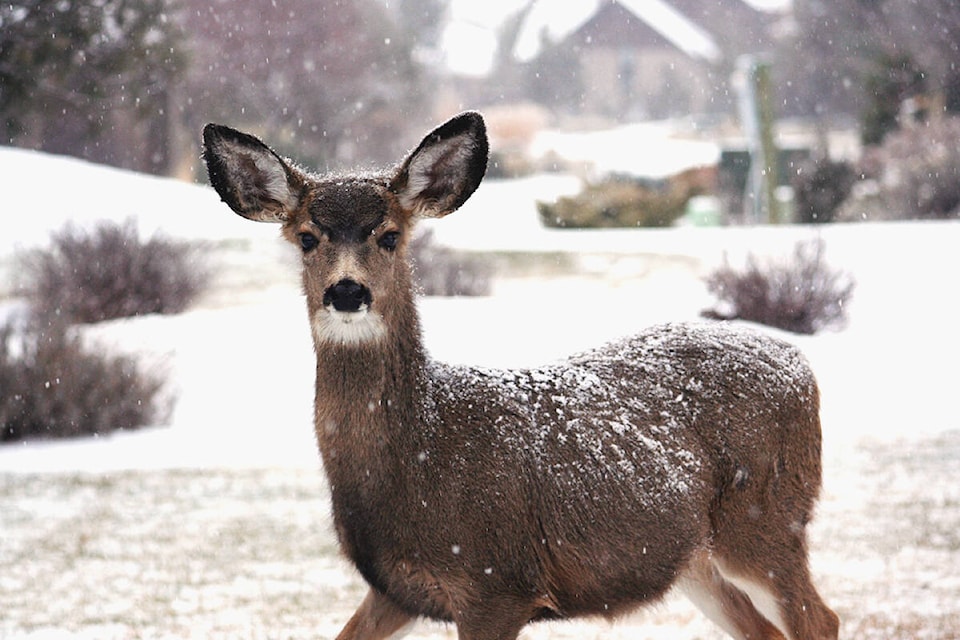Around one-quarter of Grand Forks’ urban deer are dead, following a viral outbreak brought by extreme summer heat, according to wildlife officials.
The hemorrhagic disease known as blue tongue spread rapidly among wild bighorn sheep between the city and neighbouring Christina Lake starting in mid-August. Initial data suggested a death toll of around two-thirds of the herd, re-introduced to the Gilpin Grasslands in 1986.
READ MORE: Disease reportedly kills off dozens of bighorn sheep near Grand Forks
READ MORE: Bighorn sheep die-off prompts look at Grand Forks’ history
Speaking to The Gazette Friday, Oct. 15, Caely Thacker, a wildlife veterinarian at B.C.’s forest ministry, said blue tongue is first and foremost a killer of whitetail deer. The animals aren’t tracked locally or regionally, making it difficult to estimate losses, though Thacker said recent finds of dead bighorn sheep suggest the disease has spread as far west as the Okanagan.
Appearing before Grand Forks’ committee of the whole Monday, Oct. 4, Public Works manager Alex Adams said city crews had retrieved 30 whitetail carcasses in the previous six weeks. Of that number, Adams said 60 per cent had likely died of blue tongue, attributing 30 and 10 per cent of deaths to roadkill and regular predation. Boundary Conservation Officer Kyle Bueckert on Thursday, Oct. 14, put the death toll at no less than 100, with most deaths occurring in September.
“A conservative estimate would be that 20 or 30 per cent of the urban herd is gone,” he said, explaining that between 400 and 500 deer called the city home before the outbreak.
Bueckert said he’d put down between 20 and 30 infected deer, explaining that the disease, which Thacker said is incurable, had robbed them of their eyesight and coordination. Afflicted deer were seen running heedlessly into parked cars and buildings, blood running from their eyes and swollen tongues before Bueckert said he ended their suffering.
“I didn’t get into this line of work to euthanize wildlife. But, if it means preventing an animal from further suffering, then I’ll do it,” he told The Gazette.
Bueckert and Thacker said deaths have leveled off in whitetail and bighorn since the onset of fall. The disease is spread on the wings of tiny flying midges, commonly known as no-see-ums, which can’t survive overnight frost.
Blue tongue is suspected to have caused large die-offs in the region before, but this summer’s outbreak is the first to be conclusively linked to the disease. To that point, Thacker said Southeastern B.C. may see future outbreaks if hotter than normal summers continue to encourage the midges’ spread from their native habitat in Washington state.
Blue tongue is named after symptoms Thacker said are clearly visible in deer and sheep within days of infection. In particular, Thacker said tiny blood vessels break down throughout their disease-ravaged bodies, causing their tongues to swell and bleed as the disease slowly cuts off oxygen to the extremities.
Death usually follows within a week, she said, adding that the disease impacts deer, sheep and occasionally cows and horses, but is rarely fatal in the latter two. Blue tongue will not infect predators that feed on infected animals, she said.
@ltritsch1
laurie.tritschler@grandforksgazette.ca
Like us on Facebook and follow us on Twitter.
laurie.tritschler@boundarycreektimes.com
Like us on Facebook and follow us on Twitter.
